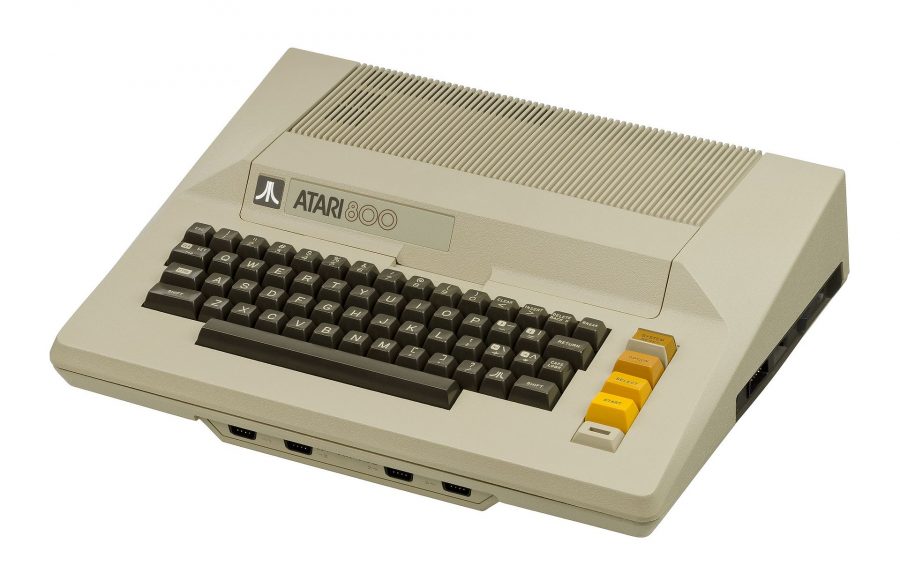As I detailed in my two previous posts on the subject (here and here), I got rid of my massive computer and videogame collection, as well as quite a bit of other associated materials (the big auction is set for some time in April or May, so stayed tuned). With 99% of the stuff in the basement gone, it’s now back to being an extremely usable space, with a nice gym, living room area, office space, and an unfinished portion that’s both a Makerspace (complete with crafting) and miscellaneous storage.

Looking down into the basement. It’s clear!
While there’s still a long way to go to fixing it up, including a fresh coat of paint and eventually replacing some outdated items, it’s already a joy to be in once again. With that in mind, I know there were several of you out there who wanted to know what the 1% of vintage stuff I decided to keep was and why. This is that explanation.

Looking into the vintage computer and videogame room, which is now functional.
First off, I obviously kept all modern computers, consoles, and handhelds (those are in the main living areas). Going forward, I’ll get rid of those as they become obsolete or a better option comes along. For the most part, I’m also all-in on digital, so amassing more physical items is not going to be an issue. This applies to books, movies, games, music, etc.

Inside the room.
So of the vintage stuff, I kept a dozen systems. Note that, of those particular platforms, what I kept was just a fraction of what they actually consisted of, included system duplicates, which all went to the upcoming auction. That also includes tons of boxed software (sadly, to a degree, since I love a lot of vintage software boxes) and all kinds of other paraphernalia.

Another angle.

A different angle.

The final new angle.

Three of four marquees that ultimately weren’t taken because of damage.
Here’s the vintage stuff I kept:
Apple II:
– Apple IIe Platinum (NTSC, full setup, several cards, etc.)

Apple IIe Plantinum.

Apple II stuff.
Atari 8-bit:
– Atari 800 (NTSC)
– Atari 1200XL (NTSC; ClearPic2002 video upgrade, R63 resistor upgrade for SIO, 28 pin EPROM OS motherboard, OS has two selectable operating systems – 800XL and Omniview+40/80 column text mode)
– Atari 800XE (PAL)

The Atari 8-bit stuff.
Commodore 64/128:
– Commodore 64c (NTSC)
– Commodore 64c (PAL)
– Commodore 128DCR (NTSC, includes JiffyDOS 128 and Servant ROM)
– Extra Commodore 1571
– Various flash devices and multi-carts and a few miscellaneous homebrew games

Commodore 128DCR.

Commodore 64 stuff.
GCE Vectrex:
– GCE Vectrex (two original controllers, one third party controller, various games, multi-carts, and overlays)

The Vectrex stuff.
Sony PlayStation 3:
– Sony PlayStation 3 (60GB launch model upgraded to 250GB Western Digital Scorpio 7200RPM, Hardware Backwards Compatibility with PS2/1)
– Steering Wheel rig (and associated games)
– Flight Stick (and associated games)
Tandy Color Computer:
– Radio Shack Color Computer 2 (NTSC, 26-3128A, Factory composite/audio out (education model))
– Radio Shack Color Computer 3 (NTSC, Triad 512K upgrade)
– Multi-pak Interface
– Various flash and multi-carts and other solutions; Sound & Speech Pak
– (see Tano Dragon)

The CoCo and Dragon stuff.
Tano Dragon:
– Tano Dragon (NTSC, Hitachi 6309 CPU upgrade)
– Various flash and multi-carts and other solutions
– Disk drive with interface and switch to go between Tano Dragon and CoCo modes
I still have several displays left, including Sony Trinitron 20″ and 32″ CRT TVs (which the auction site wouldn’t take) and a Commodore 1084S monitor. Between those, several extra LCD monitors, our other, modern TVs, and a complete XRGB-mini setup, I still have plenty of coverage and versatility in that area.
Also, I have a selection of joysticks, paddles, gamepads, and an X-Arcade with various adapters for all kinds of different systems.
You’ll note that I didn’t keep any vintage consoles other than one Vectrex, and, if you want to call it vintage (for this, I do), the PlayStation 3. For the most part, I either wasn’t interested in keeping what I had, or could easily replicate the experience in emulation or some related manner (Retro Freak, etc.).
You’ll also note that I didn’t keep any vintage computers beyond the 8-bit ones. Although I was a big Commodore Amiga user back in the day and had every system in my collection save for a 3000 and 4000, I found the 16-bit+ experience wasn’t thrilling me as much anymore. It was too finicky, too close to modern experiences, too complex for more casual usage, etc. With 8-bit computers, you get a very specific, simpler type of experience out of it all and that’s something I was more interested in exploring with my limited “hobby” time.

Heading down the now clear hallway.

For now, the living area. The PS3, PS4/PSVR (the PS4 Pro is upstairs), and Nvidia Shield are all here.

Another angle.

Turning to look into the now usable gym area again.
So why did I keep the specific platforms that I did? Here’s a summary:
Apple II: I always had a fondness for this platform. It’s one of the big three for us in the US, along with the Atari 8-bit and C-64. It will obviously be used to play games, but I’m also interested in exploring some coding activities. I debated between the Apple IIe Platinum and my well-loaded Apple IIGS, but decided I preferred the simpler 8-bit configuration. Also, the Apple IIGS has no cassette port and displays original Apple II software a little differently than earlier II’s do.
Atari 8-bit: This is another one I have some interest in exploring some coding activities on. Technically I didn’t need the Atari 800 with the other two, but I can’t resist its aesthetics, and it’s nice to have a straight up original model for guaranteed compatibility with the older stuff.
Commodore 64/128: This was my first real computer, not counting a VIC-20, so my affection for this is obvious. It’s the vintage computing platform I understand best and the one I’ll probably be turning to the most for various things. Although it may seem odd I kept the 128DCR, it not only runs C-64 software, but also 128 mode and CP/M software, as well as has a built-in disk drive, saving me one external disk drive storage space. That type of versatility is prized in my new mindset.
GCE Vectrex: This was an easier one to justify because of the unique display and experience it provides.
Sony PlayStation 3: This is the backwards compatible model, so it can play PS1 and PS2 games. However, this was really kept because I have a fancy steering wheel rig as well as a flight stick that only really work well with the PlayStation 3 and the specific games I have for it. Still, the decision was made easier by its versatility.
Tandy Color Computer: This was a tough one, but I feel like I have unfinished business with this platform. It’s not a good game machine, but it does have an interesting processor and I’d like to explore some more involved programming activities with it. I could have easily just stuck with the CoCo 3 and have been fine, but, like with the Atari stuff, I wanted to ensure maximum compatibility with older software that would benefit from the CoCo 2’s restrictions and output.
Tano Dragon: This is the odd duck, the outlier. I really only kept it because I had a disk drive with switchable interface that works on both this and the Color Computer. Since I decided to keep that disk drive for the Color Computer (I kept real disk drives for all the computers save for the Atari 8-bit, just in case), I thought what would it hurt to keep this as well, particularly since I had a few extras like a multi-cart and a flash cart for it.

Heading back down to the unfinished part of the basement.

The Maker area. 3D printing, CNC routing, laser engraving, 3D scanning, etc.

More Maker-related stuff.

Another angle.

Eventually the rest will be a more organized crafting area.

It’s hard to properly capture the different sections of the space, but you get the general idea. We’ll obviously limit how much more stuff goes everywhere. The key is to be lean and mean, and useful.
So that’s it. Again, my family and I are loving the extra space in the basement we have, freeing a whole other level of our house once again, and I’m actually able to easily use and enjoy what I have. While I will no doubt add a few things here or there for these systems, the focus will continue to be on extreme minimalism. Regardless, even before the auction takes place, I can say this move was as wonderful as I hoped it would be, despite the occasional pang of regret over letting go of a particular item or two.






 Your total news and information resource for all things Science, Technology, Engineering / Mathematics, Art, and Medicine / Health.
Your total news and information resource for all things Science, Technology, Engineering / Mathematics, Art, and Medicine / Health.
4 Comments
Leave your reply.